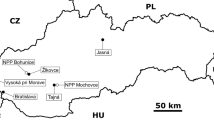Abstract
Within the framework of the BEST experiment project, a calorimetric system was developed to measure the activity of high-intensity (several MCi) neutrino sources based on 51Cr. In the range of thermal capacities of 250–520 W, the uncertainty of the heat release measurement is less than 0.25%. Taking into account the uncertainty of the energy release value for the 51Cr decay (0.23%), the activity of the neutrino source can be determined with an accuracy of ∼0.5%.







Similar content being viewed by others
REFERENCES
J. N. Abdurashitov et al. (SAGE Collab.), “Measurement of the response of a gallium metal solar neutrino experiment to neutrinos from the 51Cr source,” Phys. Rev. C 59, 2246–2263 (1999).
J. N. Abdurashitov et al. (SAGE Collab.), “Measurement of the response of a Ga solar neutrino experiment to neutrinos from the 37Ar source,” Phys. Rev. C 73, 045805 (2006).
P. Anselmann et al. (Gallex Collab.), “First results from the 51Cr neutrino source experiment with GALLEX detector,” Phys. Lett. B 342, 440–450 (1995).
W. Hampel et al. (Gallex Collab.), “Final results of the 51Cr neutrino source experiments in GALLEX,” Phys. Lett. B 420, 114–126 (1998).
C. Giunti and M. Laveder, “Short-baseline active-sterile neutrino oscillations?,” Mod. Phys. Lett. A 22, 2499–2510 (2007).
S. Gariazzo, C. Giunti, M. Laveder, Y. F. Li, and E. M. Zavanin, “Light sterile neutrinos,” J. Phys. G 43, 033001 (2016); arXiv:1507.08204.
V. N. Gavrin, V. V. Gorbachev, E. P. Veretenkin, and B. T. Cleveland, Gallium experiments with artificial neutrino sources as a tool for investigation of transition to sterile states, arXiv:1006.2103 (2010).
E. P. Veretenkin, V. N. Gavrin, S. N. Danshin, T. V. Ibragimova, Yu. P. Kozlova, and I. N. Mirmov, “Calorimetric method for determination of 51Cr neutrino source activity,” Phys. At. Nucl. 78, 1606–1609 (2015).
V. V. Gorbachev, V. N. Gavrin, T. V. Ibragimova, A. V. Kalikhov, Yu. M. Malyshkin, and A. A. Shikhin, “Measuring the activity of a 51Cr neutrino source based on the gamma-radiation spectrum,” Phys. At. Nucl. 78, 1617–1620 (2015).
V. P. Chechev and N. K. Kuzmenko, Table de radionucléides 51 Cr, Vol. 1 (BIPM, 2004).
W. Wagner and A. Pruß, “The IAPWS formulation 1995 for the thermodynamic properties of ordinary water substance for general and scientific use,” J. Phys. Chem. Ref. Data 31, 387–535 (2002).
ACKNOWLEDGMENTS
The reported study was funded by RFBR according to the research project no. 16-02-00800.
Author information
Authors and Affiliations
Corresponding author
Additional information
1The article was translated by the authors.
Rights and permissions
About this article
Cite this article
Kozlova, J.P., Veretenkin, E.P., Gavrin, V.N. et al. Calorimetric System for Determination of Activity of a Neutrino Source Based on 51Cr. Phys. Part. Nuclei 49, 758–763 (2018). https://doi.org/10.1134/S1063779618040378
Published:
Issue Date:
DOI: https://doi.org/10.1134/S1063779618040378




